
Learning module on ways to adapt products to fit foreign markets.
- Subject:
- Economics
- Social Science
- Material Type:
- Lecture Notes
- Provider:
- TeachingWithData.org
- Provider Set:
- TeachingWithData.org
- Author:
- GlobalEDGEAcademy
- Date Added:
- 11/07/2014

Learning module on ways to adapt products to fit foreign markets.

This article provides information about creating a plant or flower press and how this tool can enrich the elementary science curriculum.
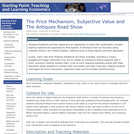
An interactive lecture segment utilizing videos from the Antiques Roadshow, designed to create an interactive experience for students and the instructor. After watching an expert appraisal of a rare/unique object students respond to discussion questions. Instructors lead the discussion toward issues of subjective value, willingness to pay, and the price mechanism.

Learning module on pricing products for foreign sale.
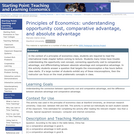
In principles of economics students many times have trouble understanding the concept of opportunity cost, connecting opportunity cost to comparative advantage, and differentiating between absolute advantage and comparative advantage. This activity allows the instructor to detect whether a large number of students exhibit any of these misconceptions, and then focus on the most problematic concepts in class.
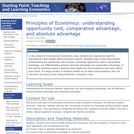
In principles of economics students many times have trouble understanding the concept of opportunity cost, connecting opportunity cost to comparative advantage, and differentiating between absolute advantage and comparative advantage. This activity allows the instructor to detect whether a large number of students exhibit any of these misconceptions, and then focus on the most problematic concepts in class.

What is a recession? What happened to the U.S. economy in 2020 and 2021, and how did the pandemic, tax and spending policies, and monetary policies affect it? What happened in 2008–2009, during the “Global Financial Crisis”? Why is inflation higher today than at any time in the last three decades? Why does the unemployment rate vary over time? Why is there unemployment at all? Why do exchange rates between currencies fluctuate? How do policies in one country affect other countries? Why do economies grow at different rates? Why has China’s growth rate exceeded that of the U.S. for more than 30 years, and will such disparities continue? What explains movements in the stock market? These are some of the core questions of macroeconomics. If you are curious about the answers, then this is the course for you.
The course is organized around four major themes: the determinants of short-run economic fluctuations; the determinants of long-run growth; the investigation of government policies, including monetary policy, government spending, and exchange rate policy; and the analysis of key economic sectors, such as consumer spending, business investment, and financial markets.
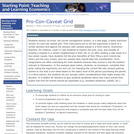
The pro-con-caveat activity is a quick and easy way to engage students through a more interactive lecture experience.
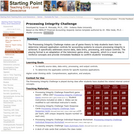
The Processing Integrity Challenge makes use of game theory to help students learn how to determine relevant application controls for accounting systems to ensure processing integrity is achieved. It specifically addresses source data, data entry, processing, and output controls. The playing format is an adaptation of the television game show, Jeopardy, which is a novel way to reinforce concepts and provide immediate feedback to confirm students' knowledge.
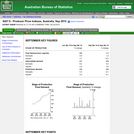
Data source updated on quarterly basis to assess commodity price changes in different sectors and as an aggregate.

This book, Project Evaluation: Essays and Case Studies, is based primarily upon materials prepared between 1997 and 2010 by Carl D. Martland for 1.011 Project Evaluation, a required course within MIT’s Department of Civil & Environmental Engineering that he designed, developed, and taught for many years. It is structured to be of interest to anyone focused on infrastructure systems, especially engineers, planners, and managers who design, build and operate such systems. The book may also be of interest to students in planning or engineering who are interested in transportation, water resources, energy, city planning, or real estate development.
Project Evaluation: Essays and Case Studies is published in two stand-alone volumes. Volume I provides an overview of project evaluation as a multi-dimensional process aimed at creating projects that meet the needs of society. Volume II examines the equivalence relationships that can be used to compare cash flows or economic costs and benefits over the life of a project.
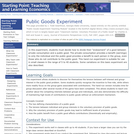
In this experiment, students must decide how to divide their "endowment" of a good between private consumption and a public good. The private consumption provides a benefit (earnings) to only the individual and the public good provides a benefit to each person in the group, even those who do not contribute to the public good. This hand-run experiment is suitable for use in small classes in the range of 5 to 40 students. Some variations on this basic experiment are also described.
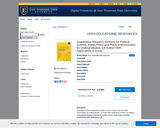
Quantitative Research Methods for Political Science, Public Policy and Public Administration for Undergraduates: 1st Edition With Applications in Excel is an adaption of Quantitative Research Methods for Political Science, Public Policy and Public Administration (With Applications in R). The focus of this book is on using quantitative research methods to test hypotheses and build theory in political science, public policy and public administration. This new version is designed specifically for undergraduate courses. It omits large portions of the original text that focused on calculus and linear algebra, expands and reorganizes the content on the software system by shifting to Excel and includes guided study questions at the end of each chapter.
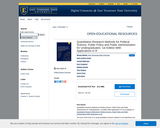
Quantitative Research Methods for Political Science, Public Policy and Public Administration for Undergraduates: 1st Edition With Applications in R is an adaption of Quantitative Research Methods for Political Science, Public Policy and Public Administration (With Applications in R). The focus of this book is on using quantitative research methods to test hypotheses and build theory in political science, public policy and public administration. This new version of the text omits large portions of the original text that focused on calculus and linear algebra, expands and reorganizes the content on the software system R and includes guided study questions at the end of each chapter.
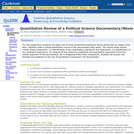
This assignment is designed to introduce quantitative reasoning and critical thinking in viewing documentary videos on the issues of development. Students will write a review essay about one of three designated documentaries for the course.
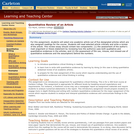
Students will read an academic article critically and write a review of the article.
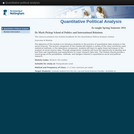
As taught Spring Semester 2011.
The objective of this module is to introduce students to the practice of quantitative data analysis in the social sciences. The lecture component of the module will explore a variety of the most commonly used statistical methods; in the laboratory component, students will learn to apply these techniques to the analysis of social science data. Through assignments, students will have the opportunity to develop and test their own hypotheses and explanations on major research data sets. The module should provide a sound grasp of the possibilities, methods, and dangers inherent in quantitative social and political research.
Module Codes: M14121 (20 credits)
Suitable for study at: Postgraduate Level
Dr Mark Pickup, School of Politics and International Relations
Dr Mark Pickup is a specialist in Comparative politics, with a particular interest in public opinion and democratic representation within North American and European countries. His research focuses on political information, public opinion, the media, election campaigns and electoral institutions.
Dr Pickup is also a Visiting Fellow in the Department of Politics at the University of Oxford, where he runs the Oxford Polling Observatory website

This article provides an overview of questioning as a reading strategy and includes templates and links to books, lesson plans, and web sites for more information.

How does energy flow in and out of our atmosphere? Explore how solar and infrared radiation enters and exits the atmosphere with an interactive model. Control the amounts of carbon dioxide and clouds present in the model and learn how these factors can influence global temperature. Record results using snapshots of the model in the virtual lab notebook where you can annotate your observations.
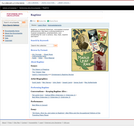
This site presents sheet music, essays, and video and sound clips related to ragtime. This distinctly American music appeared (in its published form) during the mid-1890s mainly in the South and Midwest, spread across the U.S. and to Europe, and influenced early jazz styles. Learn about Scott Joplin, one of the best known ragtime players. Hear segments of his classic Maple Leaf Rag, which helped spread the ragtime craze. See more than 100 pieces of sheet music.